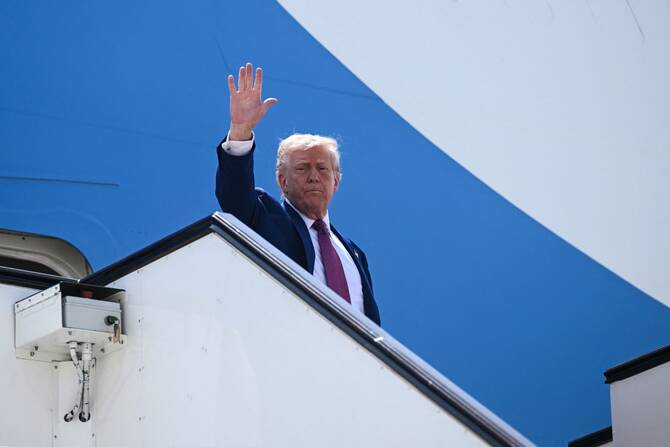
- ARAB NEWS
- 20 Aug 2025

President Donald Trump’s trip to Saudi Arabia, the UAE and Qatar last week marked a pivotal moment in US Middle East policy and signaled a profound shift in the region’s emerging political landscape. As his first foreign tour during his second term in office, the trip aimed to secure massive investment and defense deals, while proposing new approaches to the long-standing crises in Syria, Gaza and Yemen — anchored in a pragmatic vision in which influence and transactional gains are seen as pathways to stability, rather than regime change.
For the US, the visit yielded major gains: more than $3.2 trillion in investment commitments from Gulf states, including one of the largest civilian aviation deals in history with Qatar, the expansion of Al Udeid Air Base and the solidification of the US’ military presence in the Gulf. Trump’s administration emphasized a deal-oriented approach, focusing on deterring Iran, enforcing ceasefires and engaging with emerging regional players — even controversial ones, such as Syria’s new leadership under Ahmad Al-Sharaa.
Saudi Arabia emerged as the central Arab powerbroker, orchestrating the historic meeting between Trump and Al-Sharaa that led to Washington lifting sanctions on Syria. Riyadh also secured record-breaking economic and defense deals and welcomed a de-escalation in Yemen that aligned with its goal of ending the prolonged conflict. The Kingdom asserted itself as the engine of a new regional order, capitalizing on Iran’s declining influence.
The US took a deal-oriented approach, focusing on deterring Iran, enforcing ceasefires and engaging with emerging regional players
Dr. Abdellatif El-Menawy
The UAE reinforced its status as a technological and financial hub, pledging $1.4 trillion in US investments and benefiting from relaxed export restrictions on advanced artificial intelligence technologies. Abu Dhabi supported Washington’s regional agenda while promoting its image as a beacon of tolerance and modernization.
Qatar leveraged the visit to reaffirm its role as a strategic ally. It played a key role in Gaza ceasefire efforts and hostage mediation, sealed a massive aviation deal with Boeing and modernized Al Udeid Air Base. Politically, Qatar positioned itself as a trusted mediator among all parties, maintaining autonomy while aligning with the broader Gulf consensus.
On the front of regional issues, Syria took center stage. The unanticipated meeting between Trump and Al-Sharaa marked a turning point: the US announced the lifting of sanctions on Damascus, signaling the end of the Assad era. Al-Sharaa, a former militant turned political leader, pledged to expel foreign fighters, unify Syria and pursue eventual normalization with Israel. This US-backed endorsement, facilitated by Saudi and Turkish support, redefined the Syrian file and sent shock waves through traditional alliances.
In Gaza, no political breakthrough was achieved. Instead, the focus remained on a humanitarian ceasefire, prisoner swaps and rebuilding efforts, led by Qatar and Egypt. Trump’s controversial proposals for “resettling” Gaza’s population in wealthy Arab countries were flatly rejected by the Gulf states, which instead advocated for reconstruction within Gaza and under Palestinian Authority oversight — though without a clear political horizon.
Trump’s overtures to Arab capitals sent a clear message: US interests in the region may no longer be tied solely to Israel’s preferences
Dr. Abdellatif El-Menawy
The Iran file reflected a delicate balance: Trump publicly reinforced sanctions while quietly reopening diplomatic channels, notably through Oman, to explore a potential nuclear agreement. A “shadow ceasefire” was reached in Yemen, with the US pausing airstrikes on the Houthis in exchange for an end to Red Sea attacks. This convergence of Yemen and Iran strategies underscored a mutual desire to avoid full-scale conflict without conceding strategic ground.
Meanwhile, the visit accelerated the formation of a new regional order, anchored by Saudi Arabia, the UAE, Qatar and Turkiye, with US backing. This emerging coalition has effectively sidelined Iran and — more surprisingly — Israel. Tel Aviv was notably absent from all meetings and Trump’s overtures to Arab capitals without coordinating with Prime Minister Benjamin Netanyahu sent a clear message: US interests in the region may no longer be tied solely to Israel’s preferences.
Iran, on the other hand, is facing strategic retreat, having lost ground in Syria, Yemen and Gaza. While engaging in backchannel diplomacy, Tehran remains under pressure to show flexibility on its nuclear and regional policies — without yet receiving guarantees on sanctions relief.
Trump’s Gulf tour delivered immediate economic and diplomatic dividends but fell short of resolving deep-rooted conflicts. Syria may be on a new path under Al-Sharaa and Yemen has a fragile ceasefire, but the Israeli-Palestinian conflict remains politically stagnant. What has emerged is a recalibrated Middle East architecture shaped by Gulf assertiveness, strategic realignments and American deal-making. However, the broader question remains: Are these arrangements the foundation of lasting peace or merely a sophisticated exercise in crisis management?